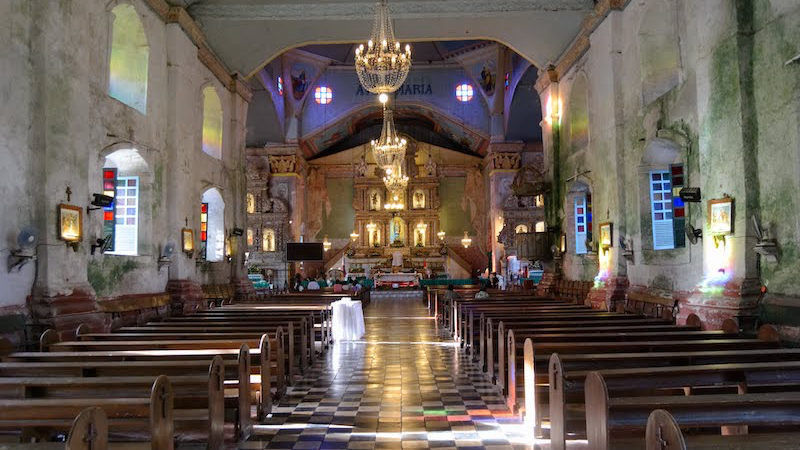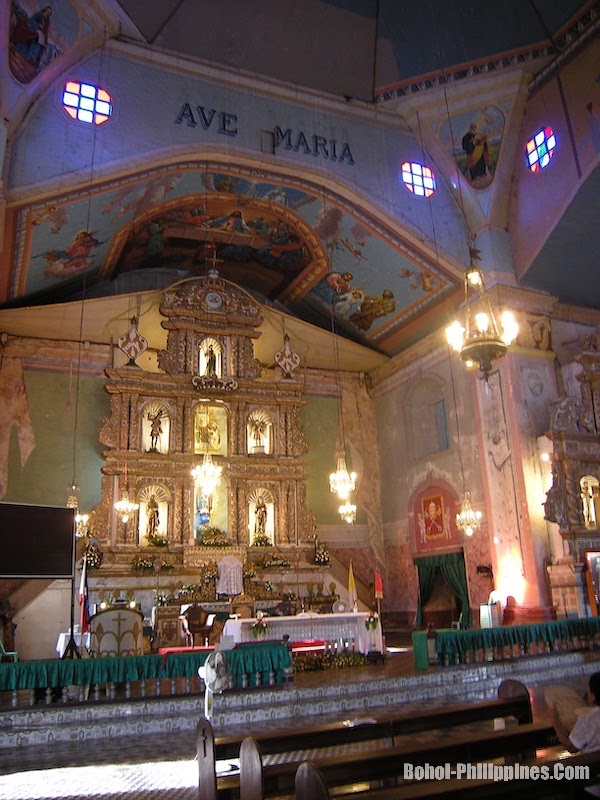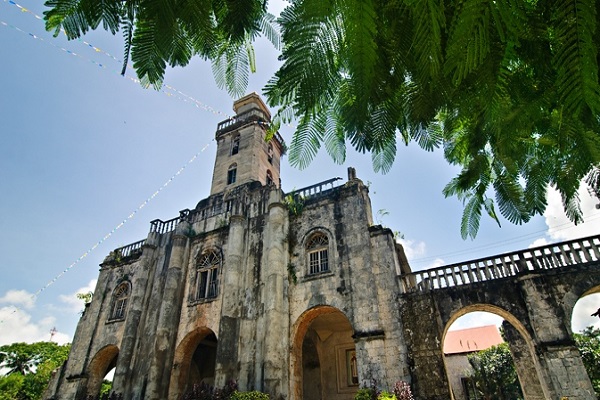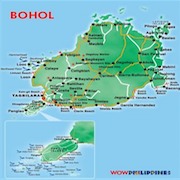⭐ BEST FERRY via CEBU & Countryside Tour: Our pick for Ferry Tickets and Countryside Tours.
- Bohol
- Bohol Attractions
- Baclayon Church
Baclayon Church: A Historical and Architectural Marvel

The Baclayon Church, officially known as the Church of Immaculada Concepcion, stands proudly in Baclayon, Bohol, Philippines. Recognized as a UNESCO World Heritage Site, this church holds the distinction of being one of the oldest in the country, with its origins tracing back to the 16th century when it was built by Spanish missionaries.
Constructed with coral stone, the Baclayon Church exhibits a simple yet elegant architectural style. Its interior is adorned with intricate religious art, including paintings, sculptures, and side altars. The centerpiece is the magnificent main altar, crafted from marble and embellished with gold and silver elements.
Visiting the Baclayon Church is a captivating experience for both religious and historical enthusiasts. As a popular tourist destination in Bohol, it welcomes visitors with open doors and does not charge any entrance fee. Exploring the church allows one to appreciate its timeless beauty and delve into the rich cultural heritage of the Philippines.

Baclayon Church architecture
The Baclayon Church is a captivating example of the blending of Spanish and Filipino architectural styles. Built using coral stone, the church exudes a simple yet elegant charm.
The church's facade showcases a combination of Spanish and Filipino influences. It features a rose window and a belfry, which are characteristic elements of Spanish architecture. These elements add a touch of grandeur and provide visual interest to the exterior.
Inside the church, Filipino motifs take center stage. The use of bamboo and wood in the interior design reflects the local craftsmanship and cultural heritage. These indigenous materials add warmth and a sense of authenticity to the space.
Notably, the church boasts two facades. The inner facade draws inspiration from classical architectural styles, while the outer facade, constructed in the 19th century by the Recollects, features a portico adorned with three arches. This addition further enriches the architectural composition and offers a unique visual appeal.

In the 19th century, the Augustinian Recollects made significant contributions to the church's architecture. They added a new facade and constructed several stone buildings that now surround the church, enhancing its overall presence and creating a harmonious architectural ensemble.
The presence of porticoes on the facade is a characteristic style observed in several churches in Bohol and Cebu during the 19th century. Porticoes can also be found in churches such as Loay, Loboc, and Cortes in Bohol, as well as Talisay and Recolletos in Cebu. This architectural feature adds a touch of uniqueness and regional character to the churches in these areas.
The Baclayon Church stands as a remarkable testament to the cultural fusion of Spanish and Filipino architectural influences, capturing the rich history and heritage of the region. Its distinctive features and architectural elements make it a captivating destination for those interested in exploring the architectural treasures of the Philippines.
Ready to explore the beautiful islands of Cebu and Bohol? Secure your ferry tickets today through 12go and start your unforgettable journey!

Baclayon Church interior plan
The Baclayon Church showcases a Latin cross plan, featuring a nave, two aisles, and a transept. This architectural layout provides a sense of symmetry and balance to the church's design.
Inside the church, visitors are treated to a visual feast of religious art. The interior is adorned with intricate decorations, reflecting the devotion and artistic craftsmanship of the time.
Notable among the interior features are the two benches carved in low relief. One of the benches depicts genre scenes, showcasing everyday life elements such as a tied goat, a coconut, a nipa grove, and a man in stocks. These carvings offer a glimpse into the cultural and social context of the period.
Several paintings grace the nave, including depictions of the Ascension, Church Fathers, and San Vicente Ferrer. These artworks date back to the 19th century, providing a glimpse into the religious and artistic traditions of the time.
Although the church had a pipe organ installed in the 1800s, it is currently in disrepair. The choir and organ loft feature decorative cut-out designs, adding a touch of elegance to the interior.
However, it's worth noting that the painting on the stucco finish of the church is of more recent vintage, dating to 1996. While it adds a contemporary touch, it deviates from the style and period of the church's interior, creating an interesting juxtaposition of artistic elements.
Behind the church and convento, remnants of fortifications can still be seen. According to oral lore, these structures were once horse stables, a kitchen, and a jail. These remnants offer a glimpse into the historical context and the multifunctional nature of the church complex.
Overall, the Baclayon Church's interior is a testament to the rich artistic heritage and religious devotion of the past. Its intricate carvings, paintings, and architectural elements create a captivating ambiance that transports visitors back in time, providing a deeper appreciation for the church's cultural and historical significance.
Baclayon Church altars retablo
One of the striking features of the Baclayon Church's interior is the presence of green and gilded altars that serve as the focal point. These altars are elaborate representations of the Baroque style, popular during the 18th century, and they exude an exuberant and ornate aesthetic.
The main retablo, or altar, prominently displays saints associated with Recollect devotion. However, it is interesting to note that the retablo itself has its origins with the Jesuits, as indicated by their emblem and motto "Ad majorem Dei gloriam" (For the greater glory of God) adorning the top of the main altar. This amalgamation of influences adds a layer of historical and artistic significance to the church's interior.
The main altar, crafted from marble, is a breathtaking sight adorned with gold and silver decorations. Its grandeur and intricate detailing showcase the craftsmanship and devotion that went into its creation. In addition to the main altar, the Baclayon Church houses several side altars, each with its own unique design and religious significance.
Among the notable artworks in the church, the most renowned is the "Our Lady of Mt. Carmel" painting. This painting holds special reverence and is believed to possess miraculous powers, attracting numerous pilgrims seeking spiritual blessings and divine intervention. It serves as a significant pilgrimage destination for those seeking solace and spiritual connection.
The combination of the grand altars, elaborate decorations, and the venerated "Our Lady of Mt. Carmel" painting creates an atmosphere of reverence and awe within the Baclayon Church. It is a testament to the religious devotion and artistic heritage of the community, inviting visitors to appreciate both the artistic beauty and the spiritual significance of this historic place of worship.
Baclayon Church windows

The Baclayon Church's colored window panes are truly iconic, adding a touch of vibrant beauty to the interior. These stained glass windows have long been admired for their intricate designs and the way they filter sunlight to create a mesmerizing display of colors and patterns.
Over time, however, the original stained glass panes have suffered wear and damage, making it difficult to replace them with exact replicas. As a result, the locally available replacements have limited options in terms of design and color. The current pattern available is primarily the classic quatrefoil "florentine" pattern, which features four overlapping circles. The color choices are also more restricted, with amber, green, and blue being the available options.
It's worth noting that the original stained glass panes, dating back to the 16th century, possessed a certain thickness and richness in color that added to their allure. While the newer replacements still contribute to the church's visual appeal, they may not fully capture the depth and character of the original stained glass windows.
Despite the limitations, the colored window panes continue to be a cherished feature of the Baclayon Church, serving as a reminder of its historical significance and artistic heritage. They contribute to the overall ambiance of the church, casting a warm and ethereal glow that enhances the spiritual experience for visitors and worshippers alike.
history of baclayon parish
The history of the Baclayon Church and parish dates back to November 17, 1596 when Spanish missionaries, Fr. Juan de Torres and Fr. Gabriel Sanchez, settled in the area and established a visita. Initially, there was no proper place to celebrate Mass, but the Jesuits convinced the locals to build a bamboo church, known as the "Residencia," which served as the center of the Bohol missions.
The mission expanded to other parts of Bohol, with Fr. Juan de Torres establishing another settlement in Loboc in 1596. Baclayon was initially the residence of the Jesuit Superior General and the center of the Bohol missions.
However, due to the constant threat of Moro raids, the Jesuits relocated their headquarters to the inland village of Loboc on October 26, 1600. Loboc became a parish in 1602 and hosted the "Residencia" until the 18th century.
Despite the Jesuits' move, life in the Baclayon settlement continued, and its inhabitants remained steadfast in their Christian faith. Unlike some other towns in Bohol, Baclayon did not participate in the Tamblot or Diwata Uprising against the Spanish conquistadors in 1621.
During the Philippine Revolution, the Baclayon Church served as a rallying point for Filipino rebels, highlighting its significance in the country's history.
construction history

The Baclayon Church, built in the 16th century by Spanish missionaries, is a well-preserved Jesuit-built church in the region. In the 19th century, the Augustinian Recollects added a modern facade and additional stone buildings surrounding the church.
Construction of the church and a 21-meter bell tower began in 1717 when the settlement was raised to parish status. Around 200 natives, through forced labor, participated in the construction. Skilled artisans obtained coral stones from the sea, while others transported and cut them into square blocks. These blocks were then meticulously assembled using bamboo poles and an adhesive made from lime and the whites of a million eggs.
Legend has it that beneath the Baclayon Church lies a dungeon where natives who violated Spanish and Roman Catholic Church rules were imprisoned. Adjacent to the church is a convent, which now serves as a museum showcasing religious relics, artifacts, and antiquities dating back to the 16th century.
Baclayon Church is the second oldest stone church in the Philippines, with its foundation laid in 1717. It was initially dedicated to Our Lady of the Immaculate Conception. A large bell was installed in 1835, and the Augustinian Recollects added the front facade with three arches and surrounding stone buildings in the 19th century. Today, it remains the most well-preserved church in Bohol.
While claims have been made about the church's age, evidence points to its construction in 1727, rather than the previously believed date of 1595. The adjoining tower, believed to have been initiated by the Jesuits, was completed during the administration of the Recollects around 1777, as indicated by a stone inscription on the tower, which has since been defaced.
The church complex was fortified with a wall by the Jesuits, and the Recollects utilized the coral stones from these walls when constructing a new wing of the convento in 1872.
baclayon museum
Next to the Baclayon Church stands the old convent, a historic building that now serves as a small museum. Inside this museum, visitors can explore a fascinating collection of religious relics, artifacts, and antiquities that date back to the 16th century.
Baclayon played a significant role in initiating the establishment of parish museums in Bohol, showcasing the region's rich cultural and religious heritage. The museum's collection is particularly notable for its extensive array of liturgical materials, which provide valuable insights into the practices and traditions of the church.
The church inventory books have been instrumental in dating many of the preserved items, shedding light on their historical significance. Among the notable discoveries found within the museum's collection are the Baclayana Mass, a musical composition for the Mass that was found in the cantorals (large handwritten music books) of Baclayon. This composition has been revived and is now part of the repertoire performed by the renowned Loboc Children's Choir.
The museum also houses an array of remarkable artifacts, including an ivory statue of the crucified Christ gazing heavenward, a statue of the Blessed Virgin believed to have been presented by Queen Catherine of Aragon, relics of St. Ignatius of Loyola, opulent gold-embroidered ecclesiastical vestments, books with covers made of carabao skin, and librettos of church music inscribed in Latin on sheepskins.
One of the museum's notable attractions is the collection of cuadro paintings created by the Filipino painter Liberato Gatchalian in 1859. These paintings provide a glimpse into the artistic talent and craftsmanship of the time, capturing scenes of religious significance and historical importance.
Visiting the museum next to the Baclayon Church offers a captivating journey through history, allowing visitors to appreciate the cultural treasures and religious devotion that have shaped the region's identity. It is a testament to the enduring legacy of Baclayon's heritage and its commitment to preserving and sharing its rich past with visitors from around the world.
events

One of the most significant events at the Baclayon Church is the Feast of the Immaculate Conception, observed on December 8th each year. This feast holds great importance in the Philippines and is commemorated with various religious processions, prayers, and festivities. It is a time when devotees gather to honor the patroness of the church and celebrate the immaculate conception of the Virgin Mary.
In addition to religious celebrations, Baclayon also hosts a vibrant cultural event known as the Baclayon Festival. Held annually in February, this festival pays homage to the rich history and diverse culture of the community. The festival showcases captivating street dancing performances, lively concerts featuring local talents, and enticing food festivals that offer a taste of Baclayon's culinary delights. It serves as a platform for residents and visitors alike to immerse themselves in the vibrant traditions and artistic expressions that characterize Baclayon's identity.
Both the Feast of the Immaculate Conception and the Baclayon Festival contribute to the vibrant tapestry of cultural and religious celebrations in Baclayon, bringing people together in joyous commemoration and fostering a sense of community pride and unity.
getting there
Accessing the Baclayon Church and its museum is a straightforward process. Here's the information you need:
Fees:
- There is no entrance fee to visit the Baclayon Church itself.
- However, there is a separate fee to enter the church's museum. The museum fee is Php 100 for adults and Php 50 for children.
Location:
- The Baclayon Church is situated in Baclayon, a charming town in Bohol, Philippines.
- Baclayon is approximately 20 kilometers away from Tagbilaran City, the capital of Bohol.
Transportation:
- To reach Baclayon, you can take a bus or jeepney from Tagbilaran City heading towards Baclayon.
- Another option is to hire a tricycle, a common mode of transportation in the area, which can take you directly to the church.
Inmaculada Concepción Parish:
- The Baclayon Church is officially known as the Inmaculada Concepción Parish.
Opening Hours:
- The church is open to the public every day from 6:00 AM to 6:00 PM.
By following these directions and guidelines, visitors can easily access and explore the historical and cultural treasures of the Baclayon Church and immerse themselves in its rich heritage.
Faith Filled Work of Art: Bohol Churches
What to See and Do in Baclayon
- Bohol Town of Baclayon - The town of Baclayon covers an area of 3442.1807 hectares or 34 square kilometers which is politically divided into 17 barangays.
- History of Baclayon - Baclayon played a prominent role in the history of Bohol since it was the first municipality ever to be established in the island by the Spaniards.
- Baclayon Tourist Attraction - The Municipality of Baclayon has several attractions, mostly heritage edifices such as the Baclayon Church of Our Lady of the Immaculate Conception, the Baclayon Museum, and the Heritage or Ancestral Houses.
- Baclayon Church - The Church of Immaculada Concepcion in Baclayon is considered to be one of the oldest in the Philippines. Construction began in 1717 where some 200 native laborers (obras pias) cut and dragged coral blocks from the sea, using only bamboos in moving and lifting the stones in position.
- Visita Iglesia to the Baclayon Church - Ever since I was small and at every visit to Bohol, I pass by the Baclayon Church on the way to my Dad’s place in Guindulman or to my Mom’s at Mahayag ...
- Baclayon Museum - A visit to the church is not complete without a stopover at the museum; carries a handful of religious artifacts that interestingly showcase the legacy that the Spaniards left on our beloved island. Looking at these artifacts, especially the vestments which are embroidered with gold, we relive the moment when these was worn, oh so elegantly!
- Baclayon Pastries - Baclayon is known locally as the pastry capital of Bohol. This pastry making activity dates back to the Spanish times. It is said that because of the volume of egg whites that were used for the construction of the church, the Spaniards taught the locals how to make cookies and other pastries while utilizing the egg yolks.
- Malon House, Baclayon Bohol Old Houses - The Malon House dates back to the late 19th century - the largest heritage house in Baclayon home to six (6) generations of the prominent Malon family.
- Picnic at Baklayon Sea - Stop and enjoy a picnic at the bayside of Baclayon. With the church in the background contemplate the blue green sea while finishing off your adobo chicken!
Top of Baclayon Church
Ready to explore the beautiful islands of Cebu and Bohol? Secure your ferry tickets today through 12go and start your unforgettable journey!
recommended hotel booking
Book your stay in Bohol's breathtaking surroundings through Agoda and experience the ultimate relaxation
Top 25 Sights and Attractions in Bohol
- Chocolate Hills
- Tarsier Conservation Sanctuary
- Panglao Island
- Loboc River Cruise
- Hinagdanan Cave
- Balicasag Island
- Alona Beach
- Bilar Man-made Forest
- Blood Compact Shrine
- Baclayon Church
- Bohol Bee Farm
- Anda Beach
- Sipatan Twin Hanging Bridge Loboc
- Danao Adventure Park
- Sagbayan Peak
- Butterfly Conservation Center
- Clarin Ancestral House
- Dimiao Twin Falls
- Mag-Aso Falls
- Anda White Beach
- Lamanok Island
- Rajah Sikatuna Protected Landscape
- Dauis Church
- Can-umantad Falls
- Punta Cruz Watchtower
Other Churches:
Albuquerque Bohol Church
Corella Bohol Church
Baclayon, Bohol, the Philippines
History of Baclayon Church
All Rights Reserved ©2024. Bohol Philippines Travel Guide
Address: Talibon, Bohol, Philippines


